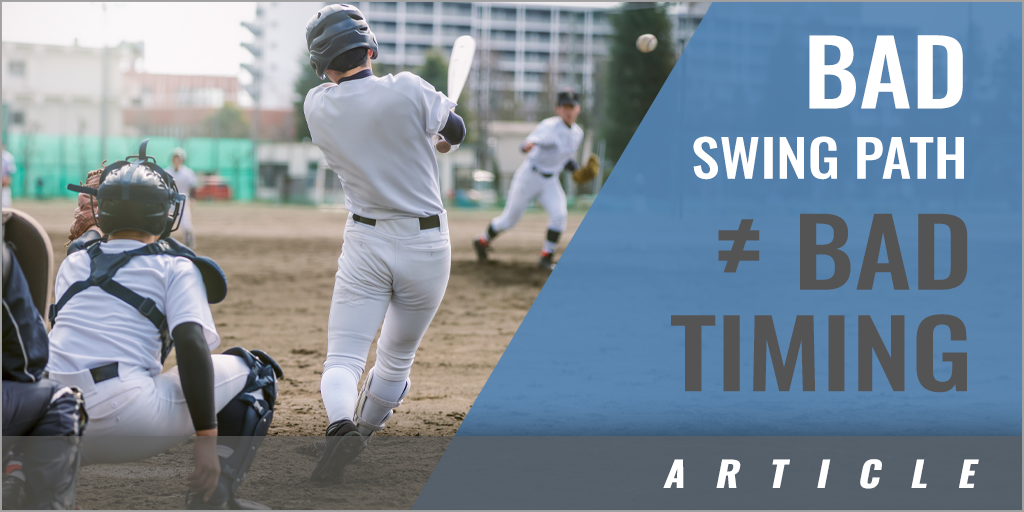|
By: Adam Sarancik Author of: Coaching Champions for Life It is certainly true that the best swing mechanics in the world are not of much value if contact cannot be made because of bad timing. However, this axiom has become a crutch for many coaches due to an inability or unwillingness to examine more closely the true cause of no or poor contact - a bad swing path. To be fair, $300.00 aluminum bats and mediocre competition disguise a lot of bad swing mechanics so some coaches may just be satisfied with fortunate results despite the long-term need for improvement in many areas of their hitters. Hitters who hit for a high batting average against elite pitching get the barrel of the bat on plane early so it passes through the hitting zone for as long as possible allowing them to make solid contact no matter if their swing is a little early, perfectly on time or a little late with the pitch. And yet, if you objectively examine frame-by-frame video of a swing that to some was not on time, you will frequently see a swing that was never on plane with the pitch. Even those coaches who correctly identify a poor swing path as the cause of poor contact tend to generalize and over-simplify their analysis to a trendy discussion of attack and launch angles. Attack and launch angles are the result of the execution of the process of the good or bad mechanics that precede them. In other words, they are consequences not solutions. Almost all faults and fixes in sports begin with a ground-up analysis of posture, balance, footwork, angles (in the body and while moving), rhythm and timing. Notice what is first on the list and what is last. If the object of a baseball swing is to get the "sweet spot" of the barrel of the bat on the ball, it does not take much imagination to understand that poor posture is going to make this extremely difficult for sharp, late-breaking pitches with high velo. Great hitters begin with and maintain athletic posture throughout their swings. I think the most overlooked cause of poor contact in baseball swings, at every level, are bad grips. Almost all baseball players from the high school varsity level up through MLB correctly grip a bat in their fingers not the palms of their hands. However, very few of them do two very important additional things – stack their hands and slightly extend the top index finger knuckle. The farther the palms of the hands are separated when gripping the bat, the more difficult it will be to keep the barrel on plane particularly when the hitter is rotating with maximum force to catch up to high velocity. When gripping a bat, the back of each hand should be at an angle to the wrist of each arm not in a straight line – Christian Yelich and Aaron Judge are two MLB players who grip a bat correctly. The slight extension of the top index finger (just as in golf) allows the barrel to maintain an optimum angle when hitting to the opposite field. If the top hand and index finger are too tight, the barrel of the bat will be slightly raised causing the hitter's swing to rollover instead of drive through a pitch on the outer third of the plate. The next culprit causing poor contact is the position of the hands and arms at the start of the swing. The hands on the bat must be inside (i.e., closer to the back shoulder) an imaginary line from the pitcher's release point to the front elbow of the hitter otherwise the hands will be "cast" when the bat is swung or, at a minimum, getting them "inside the baseball" will be very difficult against high velocity. The angle of the front arm should be a "V" not an "L" and not straight. To accomplish this, when establishing the position of the arms and hands, the elbow of the front arm stops underneath the hitter's chin as he is looking straight ahead to the opposite batter's box and the hands are raised so the top hand is even with and a baseball's width outside the back shoulder. This hands and arms position will keep the hitter's swing "inside the baseball" on all pitches when the swing is executed properly. The wrist of the top hand should be cocked and the bottom hand should not be raised so the bat is at a 45 degree angle. Next in the hitting sequence is the hitter's weight transfer. As I mentioned above, the hitter must start in an athletic posture and it must be maintained throughout the swing. The player must start in balance and must stride/ land in balance. Any slight deviation from optimum balance and posture will make getting the barrel of the bat on plane more difficult as the quality of the pitching elevates. The next faulty pattern is players trying to time their stride to land as the pitch arrives instead of striding early enough to have time to track the velocity and spin axis of the pitch. A late stride means the front foot does not get down solidly before the swing starts, the front foot spins, the front knee does not lock back to allow the hitter to swing into a strong front side, the barrel of the bat drops and another line drive is turned into a lazy fly ball or pop-up. A coach must then examine the swing itself. The first thing that must happen is the back shoulder must angle and the back knee must flex to match the plane of the baseball before the swing begins. The lower the pitch the more the back shoulder must angle and the back knee must flex. However, the angle of both is proportionate; too much angle of one and not enough in another or too much of both will cause the posture to collapse and the swing to loop. Not enough of one or both will cause the swing to be too flat and the contact with the pitch, if any, to be "rolled over". If the hands, arms and bat are located correctly at the start of the swing, the back shoulder is angled and the back knee are flexed properly according to the angle and spin axis of the pitch, when the hitter rotates his body the bat will be on plane. The hips and torso must initiate and control the swing until the laces of the shoe of the back foot are facing the pitcher at which time the arms and hands are propelled through the baseball (assuming the grip is correct). Also, poor contact will also occur if the player is trying to create "launch angle" by lifting the ball instead of driving through the ball after getting the bat on plane with the pitch. Young players, in particular, do not use their hips and torso to swing the bat because they have not established enough core strength to do so. Even coaches at higher levels miss this critical deficiency in their hitters because they fail to see and develop the athlete first before the player. Basic swing mechanics can also be the problem. Specifically, the top arm and hand are not doing their job of keeping the bat on plane with the pitch. Many hitters hit cage bombs all day off of a tee or soft toss with their front side and arm doing almost all of the work. When they face elite velo in the game, they swing and miss not usually because they are late, but rather because the barrel of the bat drops just below the ball because they're swinging the bat using almost all front side and arm and their top arm and hand are basically not involved at all. In youth baseball, many players cannot keep the bat on plane simply because they are using a bat they cannot handle, i.e., it is too long (sometimes they just need to choke up more) or too heavy for them. The final component of poor contact analysis, of course, is poor pitch recognition. First, as discussed above, this is typically a late stride and weight transfer issue. Second, hitters also cannot react to in a game what they have not recently and frequently seen in practice. Batting practices should simulate game conditions – randomized arm slots, velo and spin axes are essential in all types of batting practices drills. Bad timing can sabotage great swings, but before a coach jumps to the conclusion of bad timing, there are many other equally important factors to carefully consider, examine, and train.
Adam Sarancik is the Author of Four Amazon Top 100 Best Selling Baseball Coaching Books:
|








